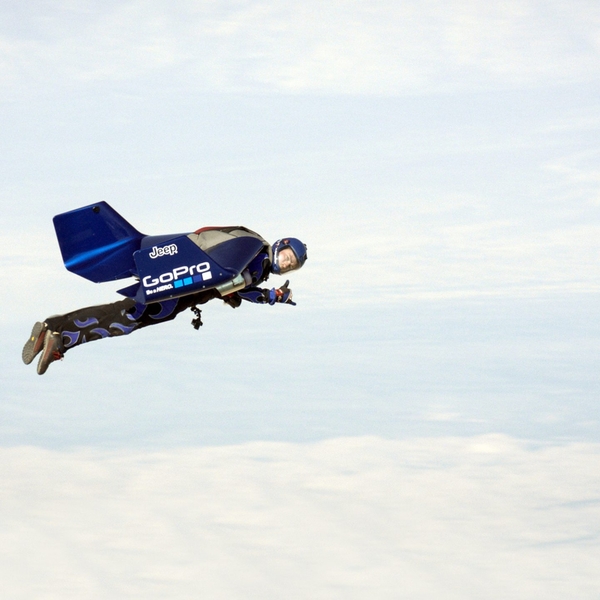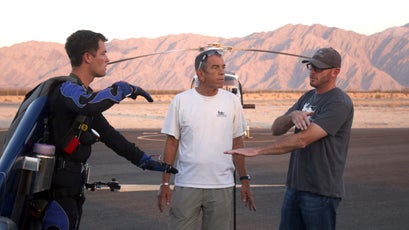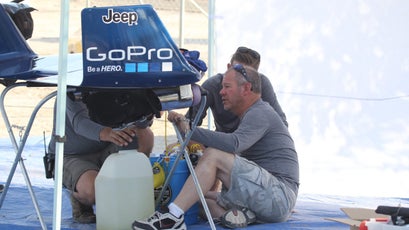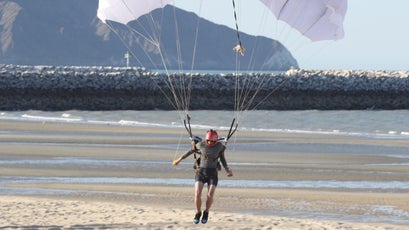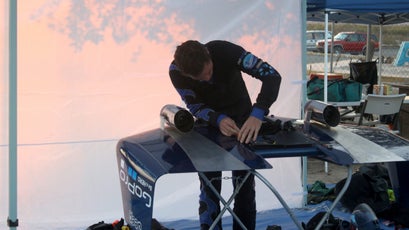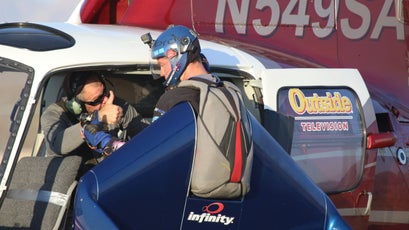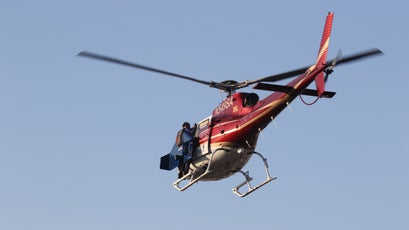Birdman
Flying around like Marvel superhero Iron Man might not yet be possible. But as wingsuit flyer, pilot, and real-life human rocket Rex Pemberton demonstrated this past June in Mexico, it's no longer a sci-fi fantasy either.
The desire to fly has been a universal human obsession since the dawn of time. From ancient Greek myths to the famous drawings of the flying machine by Leonardo da Vinci to the YouTube era of wingsuiters, we remain as fascinated as ever by the notion of flight. Rex Pemberton has been more fixated on the idea than most. The Australian adventurer has stepped off cliffs and out of airplanes more than 3,000 times to fly a fabric wingsuit, which allows him to glide for miles before pulling the ripcord.
Although soaring like a bird is thrilling, Pemberton has taken things even further. Last May, he jumped out of a helicopter in Baja, Mexico, and became one of the first people in history to pilot an honest-to-goodness personal jet-powered wing. “It’s a dream people have as kids to simply fly along in the clouds,” Pemberton says. “In Baja, I had to pinch myself a thousand times before I jumped out of the helicopter and ask myself, ‘What the hell are you about to do?’ It was ridiculous—it’s like you’re flying your own body.”
The journey from birdman to rocket man, however, took a lot of earthbound work. Pemberton, 33, began his life of adventuring in Sydney, Australia, surfing, sailing and rock climbing with his family before becoming a serious alpinist at the age of 16. By 23, he had become the youngest Australian to summit Mount Everest and the third-youngest person in the world to top out on the Seven Summits, the highest mountain on each of the seven continents. Around the same time, he began BASE jumping and skydiving—eventually discovering wingsuiting, which became his life’s passion.
As he became more experienced with wingsuiting, he realized the sport was in its infancy and still had a lot of room for development. “I was really interested in expanding the envelope of human flight and thinking outside of the box,” he says. “I wanted to see it evolve.”
That’s when he started paying attention to Felix Baumgartner, the daredevil who flew a rocket-powered delta wing across the 22-mile English Channel in 2008, and Yves Rossy, the Swiss adventurer who developed an impressive jet wing with sponsorship from Dubai. “I started thinking, why not do something like that instead of playing around with fabric,” says Pemberton.
That first blast was exhilarating. For four minutes, Pemberton shot through the air, his body acting like the fuselage of a man-sized aircraft.
But RadioShack doesn’t stock rocket wings, so Pemberton approached composite-material manufacturers in 2012, hoping he could hire them to help design a wing. The costs, it turned out, were too much for the itinerant skyman, who made his living primarily by demonstrating wingsuiting at air shows and giving motivational speeches to corporations. Pemberton was set on rocket-flying, however, so he decided he’d just have to develop the wing himself.
It was a true grassroots effort. He roped in his flight instructor and close friend Jason Johanson into the project. Jason introduced him to a farmer named Bob, who happened to design airfoils in his spare time on an ancient PC in his dusty workshop in rural California. Bob was intrigued and agreed to come up with a design.
They dubbed the project the X Wing and began developing prototypes. X-1 was simply a plywood cutout of a delta wing. Pemberton's sister Caroline, Miss Australia 2007, traced his body on a piece of wood, which they attached to the wing to work out the proportions. Over 18 months, the wings became more sophisticated, and they began integrating changes as they learned more about composite materials, control surface, and how to work out the center of gravity. Farmer Bob spent more than 200 hours designing his airfoil, which they constructed out of fiberglass and foam, with Jason’s next door neighbor, a custom car engineer, stopping by to polish it up and do body work.
X-10 was the first flight-worthy rig the team produced. That first test jump did not go well. “It stalled, and it was hard to control,” Pemberton says. “I thought, ‘Hey this is not much better than a wingsuit.' But we stuck with it. There was a big learning curve. We changed the winglets at the ends around and changed the harness system completely. Every jump we learned so much more, and eventually outmatched any wingsuit ever made.”
By 2015, the six-foot-wide X-11, made of aircraft-grade aluminum covered with a carbon-fiber skin, was ready. In an epic test flight, Pemberton flew the wing for 15 miles, from the edge of Los Angeles to Catalina Island. By May of 2016, he was ready to test his design with real jet engines, small powerhouses manufactured by JetCat, a company that usually makes engines for remote-control jets.
The challenge is, once an aircraft is jet-powered and capable of carrying people, it needs to be vetted and approved by the FAA, a long process that would slow X Wing development to a crawl. So Pemberton and his crew decided to head south to Baja, where the rules are less strict, for their test run.
Finally, Pemberton and his 50-pound jet wing flew up over the desert in a helicopter. He looked out over the empty expanse, took a breath, and dropped into the air. When he steadied the wing and leveled his flight, he cranked on the jets. That first blast was exhilarating. For four minutes, Pemberton shot through the air, his body acting like the fuselage of a man-sized aircraft.
“In less than 10 years' time, I think you’ll strap on a wing with built-in telemetry and thrust vectoring,” says Pemberton. “We’ll be able to land vertically in their front garden, just like Iron Man.”
But the X Wing learning curve took another sharp turn. During that initial flight, the engines were only getting 50 percent power, and Pemberton could not maintain altitude nor climb. On the ground, the team realized fuel was leaking into the electronics, shorting out and shutting down the engines.
After a little handiwork with duct tape and rerouting the fuel lines, they were ready for round two. On the next jump, Pemberton could feel the full force of the engines kick in, and he was able to maintain altitude at about 4,500 feet. Over the course of the next few days, each test run went successively better. By the end, Pemberton was able to fly under control and in formation with the helicopter.

It’s a big achievement for a backyard aerospace company, and already Pemberton has the X-12 and X-13, which can hold more fuel and break down for international travel, ready for testing. He hopes to showcase the 80-pound jet wings along with a partner at air shows to finance the future of the X Wing project.
But Pemberton says he’s still at the very beginning of the project. He thinks he and his team will be able to evolve the wings to the point that they can fly in formation and do complex acrobatics. And eventually, he thinks everyone might have a chance to be a rocketman. “In less than 10 years' time, I think you’ll strap on a wing with built-in telemetry and thrust vectoring and we will literally be able to take off outside our houses and fly to a friend’s 20 miles away,” he says. “We’ll be able to land vertically in their front garden, just like Iron Man.”
Sounds great, but until then we’ll settle for watching Rex push the envelope of human flight.
